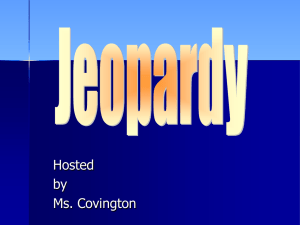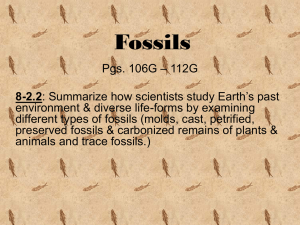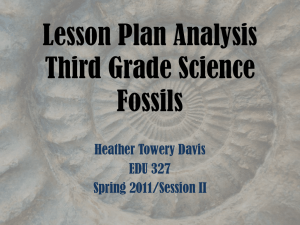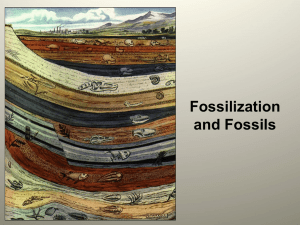Chapter 9.1: Fossils - Miami Arts Charter School
advertisement
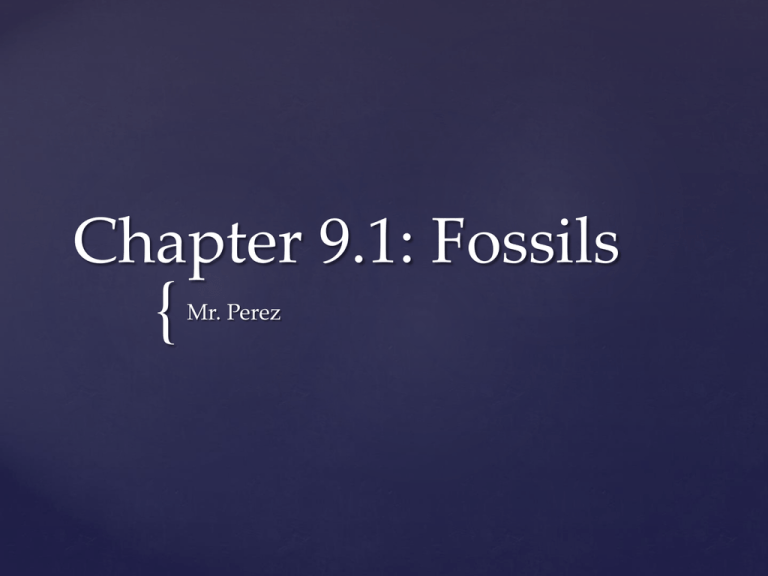
Chapter 9.1: Fossils
{
Mr. Perez
Paleontologist
Fossil
Permineralized remains
Carbon film
Mold
Cast
Index fossil
Trace fossil
Important vocabulary
A paleontologist is a scientist who studies
fossils.
They can learn about extinct animals from their
fossil remains
Paleontologists can use fossils to study the
similarities and differences of organisms that
lived in the past and compare them with those
living today.
Traces of the Distant Past
Sedimentary rock may contain fossils of plants,
animals and even some microbes.
Fossils are the remains, imprints, or traces of
prehistoric organisms
Fossils have helped scientists determine
approximately when life first lived on land,
and when organisms became extinct– they are
evidence of not only when and where
organisms lived, but also HOW they lived.
Formation of Fossils
Conditions needed to form fossils:
Protection from scavengers and agents of
physical destruction (waves, currents,
wind)
Usually, a dead organism is protect by
being buried under sediments
Dead organisms should have hard tissues
such as bones, shells or teeth
Scavengers are less likely to eat these hard
parts
These hard tissues also decay (break down)
more slowly than softer tissue
Formation of Fossils
Formation of Fossils
Mineral Replacement
Carbon Films
Coal
Molds and Casts
Original Remains
Trace Fossils
Types of Preservation
Most hard tissues of an organism have empty spaces inside
Permineralized remains are fossils in which the spaces inside are
filled with minerals from groundwater
Some original material from the fossil organism’s body might be
preserved– sometimes, DNA can be extracted
Mineral Replacement
Tissues of organisms are made of carbon
As an organism is buried, heat and pressure
squeeze gases and liquids out
A carbon film forms when a thin residue is left,
forming a silhouette of the original organism
Carbon Films
Large amounts of plant matter accumulates in
swampy areas…
After millions of years, these deposits become
completely carbonized as COAL
We use coal for fuel
Coal is not a very good fossil to inform us of
the plant’s past
Coal
Impressions form when seashells or other hard parts of
organisms fall into a soft sediment such as mud—which is
buried by more sediment
Compaction and cementation turns this sediment into a
sedimentary rock
Sometimes, there are holes in the rock that allow water and
air to dissolve the hard part of the organism inside the rock,
leaving a cavity called a mold
Later, mineral-rich water or other sediment might enter the
cavity, form new rock and produce a copy or a cast of the
original object
Molds and Casts
Molds and Casts
Sometimes conditions allow original soft
tissue of organisms to be preserved for
thousands or millions of years.
Insects trapped in amber (hardened form of tree
resin/sap)
Mammoths preserved in frozen ground in
Siberia
Natural tar deposits, such as La Brea tar pits in
California
Original Remains
Trace fossils are fossilized tracks and other
evidence of the activity of organisms
Tracks can tell you more about HOW and
organism lived than any other type of fossil
Trails and burrows can also tell scientists about
how animals lived
Trace Fossils
Species have changed over time
Fossils help provide evidence of similarities and
differences of organisms that lived in the past with those
living today.
Some species have remained the same for very long
periods of time, whereas some other species have
changed a lot
These changing species are used as index fossils, or remains
of species that existed
1.
2.
3.
on Earth for relatively short periods of time
were abundant
were widespread geographically
Index Fossils
We can use index fossils to estimate the age of
rock layers
Index Fossils
Fossils help
scientists
determine
whether an
area was land
or whether it
was covered by
an ocean at a
particular time
Fossils can also
help determine
the climate of a
past region
Fossils and Ancient Environments
Today, we will be starting a 2 day lab. This lab will
help demonstrate how fossils are formed.
Each group should have the following MATERIALS:
Paper towels
Three slices of bread (one slice each of white,
wheat, and grain)
6 Gummy candy fish (or other gummy sea animals
or plants)
Heavy books
Clear drinking straws (Day 2 only)
Fossil Formation Lab
PROCEDURE (Day 1)
1.
2.
3.
4.
5.
6.
Remove and throw away the crust of each slice of bread
Place the slice of white bread on top of one paper towel. Place
THREE gummy bears on top of the slice of bread. This represents
the sandy sea floor with a dead organism.
Place the slice of grain bread on top of your white bread layer. This
represents sediments deposited on top of dead material and settling
on the bottom of the ocean.
Place the remaining gummy bears on top of the grain bread layer and
the wheat bread on top of the gummy bears. This represents more
dead material and sediments that are deposited on top of the bottom
layers.
Fold over your paper towel, covering your stack of bread and
gummy bears.
Place a textbook on top of your bread stack to represent pressure
applied to the dead matter. Leave it under the text book for 2 days.
Fossil Formation Lab
Fossil Formation Lab
PROCEDURE (Day 2)
1.
2.
3.
4.
Observe the bread fossil. Push a clear straw straight down into the
bread and pull it back up to “extract” a core sample. Observe the
layers through the straw.
Try to separate the layers of the bread.
Try to extract the bears.
Compare the colored residue of the gummy bear in the bread fossil to
the remains of the plants and animals that seep into rock. The residue
left by the gummy bear represents oil deposits left behind by dead
ocean plants and animals. Over millions of years, these remains are
pressurized to become oil and natural gas deposits.
Fossil Formation Lab
Florida Science Grade 7
Glencoe Science & McGraw Hill Publishing
Google Images
http://www.earthsciweek.org/forteachers/2009
/FossilFormation_Sept_cont.html
Resources


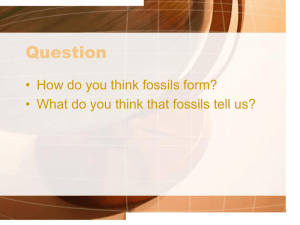
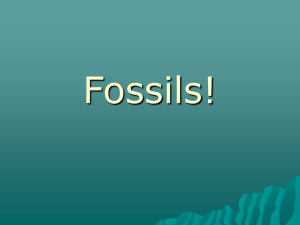
![8th_Grade_Science_EOG_Review[1]](http://s2.studylib.net/store/data/005499036_1-540adc8cddff78258f912f25485a62a4-300x300.png)
